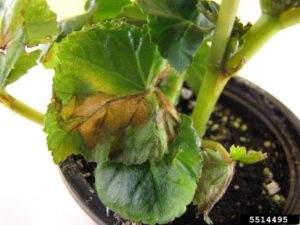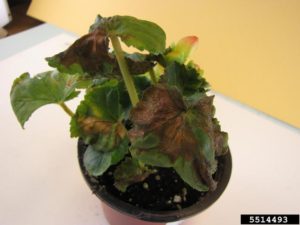Xanthomonas is both an unfortunate, but regular occurrence in the greenhouse industry. Despite the efforts from numerous companies to supply ‘clean plants’, Xanthomonas (and other bacterial pathogens) regularly slip through. This year, it came in on begonia.
The pathogen. Xanthomonas is a genus of yellow colored bacteria that infect many species of plants (approximately 400!), causing spots and blights on leaves and stems (Fig. 1). The strain Xanthomonas axonopodis pv.begonia (formerly known as X. campestris pv. begonia) is specific to begonias, and does not readily spread to other plant genera. The abbreviation ‘pv.’ is short for ‘pathovar’, which is defined as a bacterial strain that is distinguished from other Xanthomonas axonopodis strains based upon the host plant it is pathogenic to). Begonias of all species are vulnerable to this pathovar, along with creeping saxifrage (Saxifrage stolonifera).
On many crops the disease cycle of Xanthomonas spp. often begins with contaminated seeds, but outbreaks in begonia have been linked to cuttings taken from contaminated mother plants. The bacteria can also spread to healthy plants by pinching/pruning, misting of cuttings and seedbeds, by rainwater, by contaminated soil and even, possibly, by insects. Upon contact with a leaf surface, the bacteria grow on the surface of the leaf (epiphytically). Bacteria then enter into the host in three ways:
- through wounds,
- through hydathodes, natural openings at the margin of the leaf. Bacteria can then become ‘systemic’ and can then spread throughout the vascular system of the plant (Fig. 2).
- through stomata, natural openings of the leaf, to colonize the leaf tissue.
Infected plants will not recover.
Infected plants are often asymptomatic, and escape detection, which is how plants are often delivered all over the world, but the problem not identified until weeks later. Stress, particularly heat stress, triggers infected plants to exhibit symptoms. To identify infected but asymptomatic plants, elevate greenhouse temperatures to 80°F day/70°F to 75°F night for seven to ten days. The combination of plant stress and rapid bacterial growth due to warm temperatures often produces symptoms in begonias. When roguing plants, make sure plants are dry, and use disposable gloves and aprons to minimize spread.
Water. Water management is disease management, in the case of all bacterial diseases. Avoid hanging begonias above other begonias (or geraniums over geraniums, etc.) to minimize the risk of any dripping water spreading bacteria. Water roots and not the foliage–Irrigate at low pressure directed at the media, minimizing splashing water from plant to plant. When possible, irrigate by drip rather than overhead; flood irrigation and capillary mats should be avoided. Anything that spreads a lot of water can spread a lot of bacteria. Avoid late day irrigation—the goal here is to reduce humidity. Dry foliage (especially at night) is recommended to minimize spread. Don’t recycle or reuse irrigation water.
As always, spacing plants to avoid leaf to leaf contact is an important practice to prevent spread of many diseases (bacterial, botrytis, downy mildew, foliar nematode, etc.), including Xanthomonas.
Sanitation. Cleanliness is next to impossible in a greenhouse or nursery, but filth and messes can be managed or minimized. Infected plants and media should be bagged up, removed and disposed of. The bacteria can persist in crop debris and contaminated soil. Quaternary ammonium compounds (e.g., KleenGrow, GreenShield, Physan 20) are the best disinfectants to treat benches and greenhouse spaces to destroy these bacteria.
Pesticides. Although many products are labeled for bacterial control, most show very little reliable efficacy. They are best used as preventatives. Copper is considered critical for bacterial disease control (assuming the bacteria aren’t copper resistant!), and the fungicide mancozeb, have been found to be very effective. Actiguard (Acibenzolar), along with biocontrol products Triathlon BA(Bacillus amyloliquefaciens) and Cease (Bacillus subtillis) have performed inconsistently in numerous trials, but your mileage my vary. See for yourself at the IR4 Bacterial Disease Summary.
Regardless of what product you decide to use, make sure your applications are done by a low-pressure spray to minimize the spread of bacteria and risk of plant injury. As you are trying to protect the plant, and especially its leaves, you want the pesticide to remain on the plant and not run-off. In my experience, controlling bacterial diseases in the greenhouse is predicated on good sanitation and management practices, as opposed to rescue sprays after symptoms develop.

